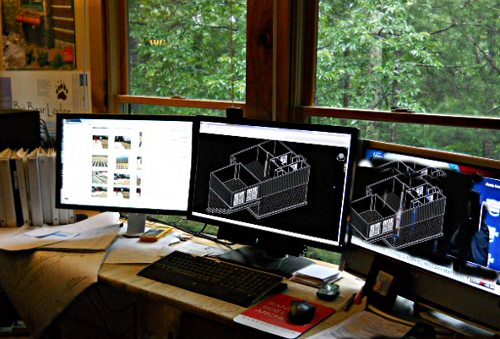Yes it is like Rocket Science: explains how properly designing a custom house is the most complex task an Architect can undertake.

Consider how an Architect works. In the image above, they often have two or three large monitors connected to a powerful computer, which is similar to what NASA scientists use. The software that an Architect uses is extremely complex. Most people give up trying to understand the complicated command structure to be able to use it. Lay people give up before they begin, which is one of the reasons they hire an Architect: it is not easy designing a house. Architects use computer software to design in both 2D and 3D, like automotive engineers (or rocket scientists) might use to design those products and items. Not that different. Only: rockets only have to last a few seconds until they are no longer of use and can be discarded. Not so with a house. It is expected to last for a century or more. The environment can be harsh: high winds, torrential rains, hail pounding roofs, snow loading the structure, bugs trying to eat it, mold trying to rot it, air trying to enter where it’s not supposed to, sun beating down on the walls, roofs, windows, doors and decks.

And there are more parts in a house than in a rocket engine. And a house is usually larger and more complex in shape: it covers many more square feet than the narrow tube of a rocket.
Ever looked inside an Air Handler Unit (the interior fan coil device used to push heated and cooled air around your house, usually through ductwork). It’s a complex piece of equipment. Or studied your hot water heater and the piping from it and your cold water, branching throughout your house like veins and arteries in a human body? Complex. Or examined how to properly ventilate and insulate and waterproof a roof or window? Complex. Or looked at the various connections between roof trusses and the roof, walls and surrounding structural members? Complicated.
And consider the number of people required to properly build a custom house: usually 50+ subcontractors working under the General Contractor (GC) and each subcontractor can have anywhere from 3 to 10 people on a crew, with perhaps 5 or so being the average. So: 5 x 50 = 250 people, plus perhaps 4 with the GC = 254 people. That’s a lot of people involved in building a house, with a host of skills, to properly build it. And that doesn’t include the other hundred people involved in designing it, financing it, insuring it, permitting it and reviewing it. If it did, that would total about 354 people. Any way you interpret it, having over 300 people focused on one patch of ground, designing and building an intricate three-dimensional object (called a house) over the course of many months or a year or more, = a very complex activity in human society and commerce.
We challenge any rocket scientist anywhere in the world to properly design a house and produce the detailed CDs (Construction Documents) to resist the elements.
Continued below:
Our bet is that there will be no takers. Just as no Architect would attempt to design a rocket (which is actually simpler). The point being: let’s all understand that each professional out there is reasonably good at what they do: Attorneys handle legal issues for us. Accountants calculate our taxes. Physicians diagnose our health issues and perform operations and prescribe medications. Detectives figure out who did things and bring them to justice. And yes, rocket scientists engineer rockets. But none of those people design houses. Why? Because it is difficult and requires not only a lot of brain power, but experience, using lessons learned over decades. Just as the rocket scientist learns from his/her successes (and blown-up rockets) so does an Architect. But an Architect can’t allow their Clients’ projects to blow up, like a rocket scientist can. No. Every single house design has to work, be durable, keep out water, be energy efficient, stand strong in the face of high winds and resist all the other elements while simultaneously providing comfort, large views of beautiful vistas, accommodate the lifestyles desired by the owners, and provide comfort, joy and beauty for the clients to enjoy all of their lives in that house.
There is an independent 3rd party website: ArchitecturalFees.com which has some interesting content, all about architectural fees, which is the sole purpose of that website. For instance, this webpage on that site is about architectural complexity:
http://architecturalfees.com/project-complexity/
Continued below:
What this indicates is the following:
“Group 1 Least Complex” projects:
include industrial buildings, parking garages, warehouses and utility buildings.
“Group 2 Simple” projects:
Armories, apartments, cold storage facilities, hangers, manufacturing plants.
“Group 3 Intermediate” projects:
College classroom buildings, convention halls, detention centers, extended care projects, gymnasiums, laboratories (presumably including those dedicated to rocket science), medical offices.
“Group 4 Complex” projects:
Aquariums (been to SeaWorld and other state of the art aquariums: Gatlinburg, Charleston and others: those are very complex), auditoriums (very complex), art galleries (have you seen the High Museum of Art in Atlanta? (very complex)), communications buildings (like cell phone and other facilities, including satellite tracking (NASA, etc.), theaters.
“Group 5 Most Complex projects:
CUSTOM RESIDENCES, special decorative buildings, custom designed furnishings.
Let’s see that again: CUSTOM RESIDENCES are in the MOST COMPLEX category of architectural projects.
There are also multiple State and other governmental agencies that indicate that the design of a custom residence is among the Most Complex & Complex categories. There seems to be a virtually universal consensus from authoritative sources that houses are very complex facilities for Architects to design.
Rand Soellner, ArCH, NCARB, award-winning Senior Staff Architect of HOME ARCHITECTS, said:
“I have designed, planned and managed the creation of some very complex facilities in my life, including a NASA Optical Laboratory (that calibrated the cameras that tracked the Space Shuttles (more rocket science)), VA Hospital ICUs, a Neonatal ICN, Operating Suites, Utility tunnels serving large medical facilities, parking garages, high schools, elementary schools, restaurants, military projects, major airport renovations (at Orlando International Airport, Miami International Airport and others), high-rise, mid-rise and low-rise condominiums, water supply and sewer facilities for most of Orange County and Orlando, Florida, about half of Jurassic Park (for Universal Studios in Orlando) and many other facility types, totaling more than $3 Billion worth of architectural planning, design and construction. I’ve been at this for 50 years. Nothing is as complex, per square foot, as the design of a Custom Residence. Why: because there is more happening in each square foot than in other facility type.”
“Anyone who thinks they can knock out a properly designed and documented house in 3, 4 or 5 sheets of drawings is asking for trouble. Their Clients deserve better than that. There is a tremendous amount of detail that should be planned, designed, detailed and specified in a custom house project, which takes many drawings and specifications, to properly define so that our Clients have what they need for their Contractors to do a proper job. I feel sorry for anyone that doesn’t do a complete and good job and I also feel sorry for their Clients (for instance: unlicensed “residential designers” are notorious for skimpy sets of documents). This might satisfy a temporary politically expedient desire on the part of the Owner to have cheap “plans”, but those savings are going to be forgotten the second there is a problem with the house. For instance: I saw where the State of North Carolina suspended the license of another Architect who failed to detail the flashing and support angle under a span of brick over a window opening in a set of house drawings. Many people might think the State’s Board of Architecture (BOA) went overboard there, because the Architect’s drawings had a note: “Comply with Code”, and that flashing is required by the IRC (International Residential Code). However, the State BOA said in its ruling that Architects must also show important details like this, not just make a general statement referring to Code. Why: because the wall had water intrusion, rotted and partially collapsed. In our society, owners of houses take their residence very seriously and expect a higher standard of care when they engage an Architect. While they might not appreciate paying for the necessary CDs (Construction Documents) to guard against such failures, they will certainly enjoy a much more trouble-free house over the decades and it will become a source of pride that their Architect planned and detailed so well. And the lack of (or at least less) maintenance required by a better detailed and better built house will save more than the Architect’s fee over the decades.”
Bottom Line: the design and documentation of a custom house is More complex than rocket science (when properly done).
So in that regard: Yes it is like rocket science.
tags: Yes it is like rocket science
